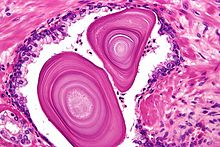- Corpora amylacea
-
Corpora amylacea, also known as prostatic concretions, are small hyaline masses of unknown significance found in the prostate gland, neuroglia, and pulmonary alveoli. They are derived from degenerate cells or thickened secretions and occur more frequently with advancing age. While their significance is unknown, they can be used to identify these organs microscopically.
In the prostate, they usually appear in benign glands; however, they cannot be used to exclude cancer.[1]
References
- ^ Christian JD, Lamm TC, Morrow JF, Bostwick DG (January 2005). "Corpora amylacea in adenocarcinoma of the prostate: incidence and histology within needle core biopsies". Mod. Pathol. 18 (1): 36–9. doi:10.1038/modpathol.3800250. PMID 15309020.
Categories:
Wikimedia Foundation. 2010.

